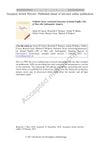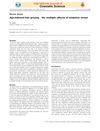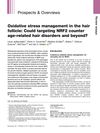Search
forLearn
5 / 6 resultslearn Melatonin
hormone commonly taken for sleep aid has some topical benefits for hair
learn Azelaic Acid
acid used for antimicrobial, anti-inflammatory and anti-androgenic properties
learn Stem Cell Factor
learn Neem Oil
natural substance from Neem tree with medicinal and pesticidal properties
Research
5 / 1000+ results
research Preparation of Finasteride via Oxidative Elimination of 2-Iododihydrofinasteride Using Peroxydisulfates as Oxidizing Agents
Using K2S2O8 as an oxidizing agent in a specific condition, we can make Finasteride with 96.3% yield and 99.6% purity. This method is also good for other compounds and is environmentally friendly.
research Does Maternal Exposure to Artificial Food Coloring Additives Increase Oxidative Stress in the Skin of Rats?
Maternal exposure to artificial food coloring may increase skin disease risk in rat offspring.

research Oxidative Stress-Associated Senescence in Dermal Papilla Cells of Men with Androgenetic Alopecia
Oxidative stress affects hair loss in men with androgenetic alopecia.

research Age-Induced Hair Greying: The Multiple Effects of Oxidative Stress
Hair greying is caused by oxidative stress damaging hair follicles and melanocytes.

research Oxidative Stress Management in the Hair Follicle: Could Targeting NRF2 Counter Age-Related Hair Disorders and Beyond?
Activating NRF2 might help treat hair disorders by improving antioxidant defenses.
Community Join
5 / 109 resultscommunity Anything you use without scientific backing, just trusting your gut?
The conversation discusses using peppermint oil for hair loss, with one user applying it undiluted to the scalp and another combining it with finasteride and microneedling. Some believe in its effectiveness despite limited scientific evidence, and also mention rosemary oil as potentially beneficial.
community 8 years of hair loss, turning 30 next month
The user has been dealing with hair loss for 10 years, worsened by psoriasis, and uses minoxidil and finasteride. They seek advice on managing psoriasis and hair loss, with suggestions to see a dermatologist, try different shampoos, and be patient.

community Compressed part of research of theory of androgenic/anabolitic balance. AGA h-responders analytic. Theory of physio-metabolitic method of anti AGA treatment
The treatment for androgenetic alopecia involves using finasteride and minoxidil with intense exercise and cold exposure to boost metabolism and reduce androgenic effects, potentially leading to hair regrowth. This approach may activate biological pathways for improved hair and overall health.
community Eliminating scalp itch leads to regrowth (and my RU58841 progress)
User experienced hair regrowth after eliminating scalp itch with RU58841. Others discussed itch and hair loss connection, and effectiveness of combining RU58841 with 5AR inhibitors.

community If You Have DUPA, PLEASE READ THIS: Everyone Should Be Scalp Biopsied
Scalp biopsies are crucial for diagnosing hair loss conditions like Diffuse Unpatterned Alopecia (DUPA) and retrograde hair loss, as treatments like finasteride and dutasteride may not be effective if other conditions are present. Combining PPAR-GAMMA agonists with retinoids could improve treatments for conditions like Lichen Planopilaris.